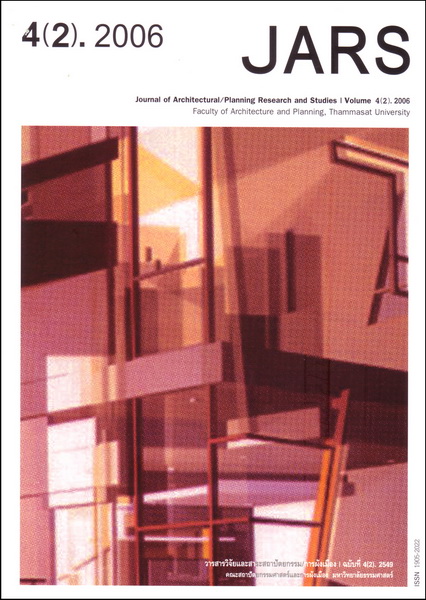The National Assembly: An Empty Promise to Democracy
Main Article Content
Abstract
Throughout history, architecture and urban design have been manipulated to serve politics. Capitals and capitols have become grand symbolic tools for the state, which should be understood in terms of their political and cultural contexts that helped bring them into being.
Accordingly, by presenting a multi-dimension critical inquiry of the National Assembly in Bangkok, Thailand, this paper argues via semiology, or a study of signs that the design of the Assembly fails to signify its original purpose: democratic ideology and practice. Ironically, however, such symbolic deficiency precisely captures the reality of democracy in Thailand. Here, democracy does not function merely as an ideology, but as a political discourse full of incongruity, paradox, manipulation, and deception.
In addition, through a critical urban study, this article reveals that the obscurity of the Assembly both in Thai architectural literature and in the urban fabric of Bangkok exemplifies the true state of the legislative branch of the government. A lack of integration between the Assembly and the physical condition of Bangkok notably the Rajadamnoen Avenue, ‘ the corridor of power,’ further demonstrates that the parliament is a rather weak and neglected institution. Significant political policies and decisions are formed and made
elsewhere. The parliamentary system acts merely as a tool for self-legitimization and authority-preservation in a game of power politics in Thailand.
Downloads
Article Details

This work is licensed under a Creative Commons Attribution-NonCommercial-NoDerivatives 4.0 International License.
All material is licensed under the terms of the Creative Commons Attribution 4.0 International (CC-BY-NC-ND 4.0) License, unless otherwise stated. As such, authors are free to share, copy, and redistribute the material in any medium or format. The authors must give appropriate credit, provide a link to the license, and indicate if changes were made. The authors may do so in any reasonable manner, but not in any way that suggests the licensor endorses you or your use. The authors may not use the material for commercial purposes. If the authors remix, transform, or build upon the material, they may not distribute the modified material, unless permission is obtained from JARS. Final, accepted versions of the paper may be posted on third party repositories, provided appropriate acknowledgement to the original source is clearly noted.
References
The Association of Siamese Architects. (1993). Pattana Naew Kid Lae Roopbab Khong Ngan Satapattayakum: Adeet, Patchuban Lae Anakot [Development of contemporary Thai architecture: past, present and future]. Bangkok: Author.
Horayangkura, V. (1993). Hok Thossawat Hanng Satapattayakum Thai Samai Mai [Six decades of modern Thai architecture]. The Association of Siamese Architects Journal, September, 45-60.
Kalayanamitr, C. (1982). Silpa-Satapattayakum Thai: Ittipol Satapattayakum Baep Tawantok [Thai art and architecture: Western influence]. In Krugrit Pramoj (Ed.), Laksana Thai. Bangkok: Thai Wattanapanit.
Poshyananda, A. (1992). Modern art in Thailand: Nineteenth and twentieth centuries. Singapore & New York: Oxford University Press.
Prakitnondhakarn, C. (2004). Karnmuage Lae Sungkhom in Slipasattapattayakum: Sayam Samai, Thai Prayuk, Chatniyom [Political and social factors in Thai art and architecture]. Bangkok: Matichon.
Tiptas, P. (1982). Quarmpenma Khong Wishasheep Satapattayakum Nai Pratet Thai [The history of architectural profession in Thailand]. Bangkok: Association of Siamese Architects.
Thailand, Secretariat of the Parliament. (1988). The Anantha Samakhom Throne Hall. Edited by Tongthong Chandransu. Bangkok: Aksorn Samphan Printing.
Thailand, Secretariat of the Parliament. (1999). Guide to the National Assembly, the House of Parliament. Bangkok: Author, GPO.
Thailand, Office of the Prime Minister. (1968, August). The cabinet’s approval for the construction of the new House of Parliament. Meeting minutes.
Thailand, Secretariat of the Parliament. (1974). Forty-second anniversary of the Thai parliament (1932-1974). Edited by Prasert Pattamasukond. Bangkok: The Library of the Parliament, GPO, 676, 677, 952, 968, 1025, 1026.
Sang-Aroon Art and Cultural Center. (1989). Thailand: Two decades of building design 1968-1989. Bangkok: Creative Print, 15.
Noobanjong, K. (2003). Power, identity, and the rise of modern architecture: From Siam to Thailand. Dissertation, Denver: University of Colorado, 267-282.
Duang-Jaiya, & Associates Architect. (1991). Arkarn Rattasapha [the House of Parliament Building]. The Association of Siamese Architects Journal, 19, 19.
Thailand, Secretariat of the Parliament. (1999). Guide to the National Assembly, the House of Parliament. Bangkok: Author, GPO, 11.
Thailand, Secretariat of the Parliament. (1999). Guide to the National Assembly, the House of Parliament. Bangkok: Author, GPO, 14-16.
Duang-Jaiya, & Associates Architect. (1991). Arkarn Rattasapha [The House of Parliament Building]. The Association of Siamese Architects Journal, 19, 19.
Thailand, Secretariat of the Parliament. (1988). The Anantha Samakhom Throne Hall. Edited by Tongthong Chandransu. Bangkok: Aksorn Samphan Printing.
Rattakasikorn, Sang-Aroon. (1974). Suan Rattasapha [Garden in the House of Parliament]. The Association of Siamese Architects Journal, 3(3), 25-28.
Frampton, K. (1992). Modern architecture: A critical history (3rd ed.). New York: Thames and Hudson, 254-257.
Saussure, F. de, Bally, C., Sechehaye, A., Riedlinger, A., & Baskin, W. (1966). Course in general linguistics (1st ed.). New York: McGraw-Hill.
Goodman, N. (1968). Languages of art: An approach to a theory of symbols. Indianapolis: Bobbs-Merrill.
Bonta, J. P. (1979). Architecture and its interpretation: A study of expressive systems in architecture. New York: Rizzoli.
Dovey, K. (2001). Memory, democracy and urban space: Bangkok’s path to democracy. Journal of Urban Design, 6(3), 265-282.
This claim was made despite the fact that Oscar Niemeyer, the chief architect of Brazilia, was a communist. Also see Vale, L. J. (1992). Architecture, power, and national identity. New Haven & London: Yale University Press, 120.
Foucault, M. (1988). On power. In L. Kritzman (Ed.), Michael Foucault. New York: Routledge.
Vale, L. J. (1992). Architecture, power, and national identity. New Haven & London: Yale University Press, 188-189.


